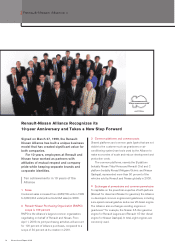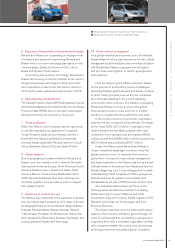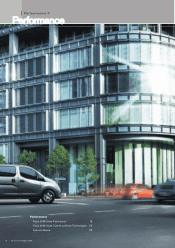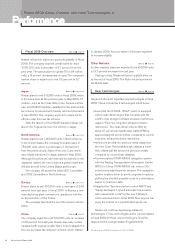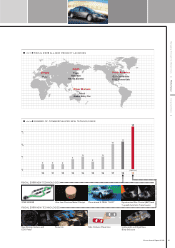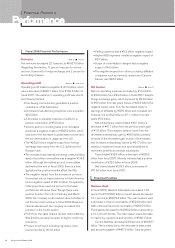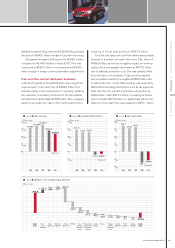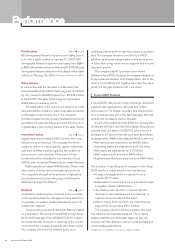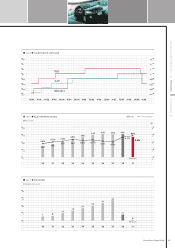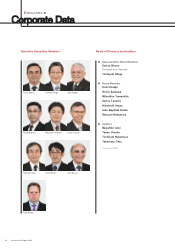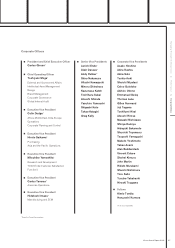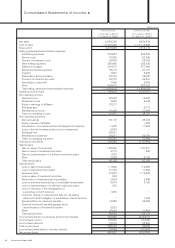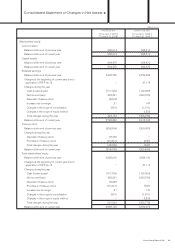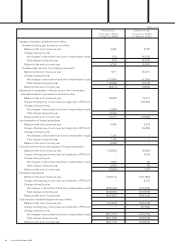Nissan 2009 Annual Report Download - page 26
Download and view the complete annual report
Please find page 26 of the 2009 Nissan annual report below. You can navigate through the pages in the report by either clicking on the pages listed below, or by using the keyword search tool below to find specific information within the annual report.
Credit rating Refer to chart 09
R&I downgraded Nissan’s long-term credit rating from A
to A- with a stable outlook on January 27, 2009. S&P
downgraded Nissan’s long-term credit rating from BBB+
to BBB with a stable outlook on February23, 2009.Moody’s
downgraded Nissan’s rating from A3 to Baa2 witha stable
outlook on February 25, 2009. (All ratings, as of March 31, 2009)
Sales finance
In conjunction with the decrease in retail sales, total
financial assets of the sales finance segment decreased
by 13.1 percent to ¥4,638.9 billion from ¥5,338.0 billion
in fiscal 2007. The sales finance segment generated
¥33.2 billion in operating profits.
The deterioration of the economy put pressure on credit
losses and led the company to make conservative pro
visions.
Credit quality control remains one of the company’s
priorities. Despite this, the company maintained the level of
penetration for loans and leases at around 45 percent on
a global basis, while providing support to the sales division.
Investment policy Refer to chart 10
Capital expenditures totaled ¥383.6 billion, which was
4.5 percent of net revenue. The company elected to
postpone, reduce or cancel specific capital investments
until there is better visibility regarding the duration of
the economic crisis. However, 50 percent of total
investments will be dedicated to new vehicles in fiscal
2009 in order to maintain Nissan’s future competitiveness.
R&D expenditures totaled ¥455.5 billion. These funds
were used to develop new technologies and products.
The company’s strength is the extensive collaborative
and development structure they enjoy with Renault’s
R&D team through the Alliance.
Dividend Refer to chart 11
An attractive dividend policy continues to be one of the
most important policies for management. And adherence
to a globally competitive dividend standard is key to its
shareholder relations.
The previously proposed dividend plan had been based
on a forecast for the period of fiscal 2008 through fiscal
2010, which was part of the NISSAN GT 2012 medium-
term business plan. However, in response to the current
environment, the company suspended the dividend plan.
The company will revisit the dividend policy once
conditions improve and free cash flow returns to a positive
level. The company remains committed to its R&D
activities, as they are indispensable for the development
of future technology, which in turn supports and ensures
long-term growth.
The company paid ¥11 per share as an interim
dividend in fiscal 2008. However, the company decided not
to pay a year-end dividend
to its shareholders, due to the
decline in profitability and negative free cash flow. As a
result, the full-year dividend is ¥11 per share.
Fiscal 2009 Outlook
In fiscal 2009, risks involve foreign exchange, distressed
suppliers, raw material price rebounds and further
deterioration in TIV. Nissan considers that opportunities
lie in exchange rates and in the hard synergies they will
develop with its Alliance partner, Renault.
In light of the outlook for fiscal 2009, the company filed
its forecast with the TokyoStock Exchange. Assumptions
included retail unit sales of 3,080,000 units, which is a
decrease of 9.7 percent from the prior year, and foreign-
exchange rates of ¥95 to the dollar and ¥125 to the euro.
●Net revenues are expected to be ¥6,950 billion
●Operating losses are expected to be ¥100 billion
●Net losses are expected to be ¥170 billion
●R&D expenses will amount to ¥400 billion
●Capital expenditures are expected to be ¥350 billion
The evolution in operating profit, compared to the fiscal
2008 results, is mainly linked to four key factors:
●Foreign exchange, which is expected to be a
negative ¥170 billion
●Deterioration in volume and mix is estimated to have
a negative impact of ¥200 billion
●Purchasing cost reduction, combined with the
decrease in raw material prices from last year, is
expected to be a positive ¥150 billion
●Others, mainly driven by fixed cost reductions, are
expected to be a positive ¥257.9 billion
The company strives to achieve a positive free cash
flow based on the assumptions above. The company
believes that this is an achievable target, as they will
continue with their efforts to improve working capital and
control capital expenditures.
(All figures for fiscal 2009 are forecasts, as of May 12, 2009)
24 Nissan Annual Report 2009


